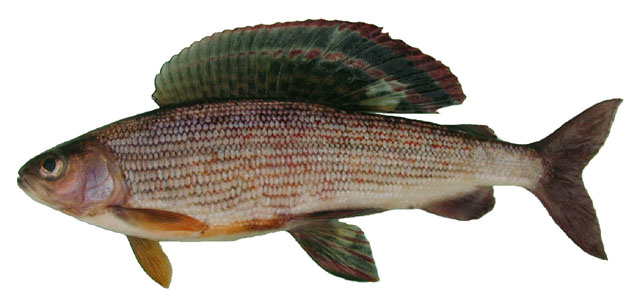| Salmonidae (Salmonids), subfamily: Thymallinae |
| 25.5 cm SL (male/unsexed); max. reported age: 6 years |
|
pelagic; freshwater |
| Asia: Lower Amur River Basin in Russia. |
|
Vertebrae: 49-55. The species is characterized by the following: Pored lateral line scales 75-91; unbranched rays in first dorsal fin 8-12, in second dorsal fin 13-17, total dorsal fin rays 23-26; number of vertebrae excluding urostyle 49-55; pyloric caeca 11-20; a wide red to maroon edging with the width 5-6 mm is seen along the upper margin of the dorsal fin, broadening towards the posterior end of the fin (in large males it may be 10 mm in width or more); below it , parallel with the edging, there are 4-5 rows (bands) of same-color spots; the upper row is slightly separated
from the edging and the bands below, and consists of the largest, slightly horizontally elongated oval spots; the lowest row of the spots, adjoined to the fin base, is weakly pronounced; bright orange sinuous stripes between the scale rows going along the body.; upper jaw overlaps with the anterior margin of the eye; length of dorsal fin base is from 25.3 to 33.3% SL; body significantly compressed laterally, its average depth is 22.9% SL; no teeth on vomer (Ref. 57969). |
| The species spawns in rivers of the Amur Basin from the middle to the end of May, 7-10 days
before the T. grubei flavomaculatus. The autumn downstream migration in tributaries of
the lower Amur takes place from September to October. The range of the food components of the Lower Amur grayling in the Anyui River in July is represented by various zoobenthos organisms. The most weight part in the food boluses of fish older than the age 3+ is
represented by mayfly and stonefly larvae, imago caddis and bugs. The composition and the frequency of occurrence of different organisms in the food boluses of the Lower Amur grayling. Comparison of the feeding spectra in the Lower Amur and yellow-spotted graylings caught in the same stations did not reveal any significant differences in the diversity of the food components (Ref. 57969). |
|
Not Evaluated (N.E.) Ref. (130435)
|
| harmless |
Source and more info: www.fishbase.org. For personal, classroom, and other internal use only. Not for publication.

